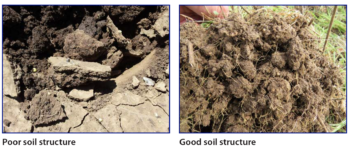How to Add Compost on Your Small Farm
Compost provides nutrients to plants, improves soil structure, increases water holding capacity, and suppresses root diseases by supporting beneficial microorganisms in the soil. It also helps improve porosity and the friability or ability to work the soil. It also increases water penetration and exchange of gases, reduces compaction, and improves the soil texture.
Compost Can…

Improve drainage and reduce flooding.

Improve soil structure

Improve soil health and nutrient supply
How to Add Compost to Your Farm
- How much compost do I need?
5-10 tons per acre is ideal, but lesser amounts, 1-2 tons/acre also help improve soil quality and function. Not more than 15T per acre.
For 1 acre: 5-10 tons
For 2.5 acres: 13-25 tons
For 3 acres: 15-30 tons - Does the company sell by the yard or ton?
1 ton = 2.5 yards (approximately) - How much will it cost? (note: compost costs vary around the state of California, but generally range from $30-$50/ton)
For example, compost costs $49 per ton, but how much per cubic yard?
$49/2.5 = $19.60 per yard
For example, compost costs $17 per yard, but how much per ton?
$17 x 2.5 = $42.5 per ton - Does the compost company deliver and spread? What is the cost of each?
For example, if it costs $39/ton (2000 lbs) for compost including delivery, and $10/ton to have it spread:
If adding 10 tons/ acre:
For 1 acre of compost delivered + spread on the farm = 1acre x 10 tons/acre x $49 = $490
For 2 acres of compost + spread on the farm = 2 acres x 10 tons/acre x $49 = $980
If adding 5 tons per acre:
For 1 acre of compost spread on the farm = 1acre x 5 tons/acre x $49 = $245
For 2 acres of compost spread on the farm = 2 acres x 5 tons/acre x $49 = $490 - Timing of compost application varies depending on the crop, soil type and locations where it is applied.
Many farmers spread compost in the fall so when spring arrives the material is incorporated in the soil. Fall applications also are used because the weather may allow applications before planting in the early spring. In order to reduce nutrient leaching a late winter or early spring application can be done if there is a dry period that would allow it.
Resources
- Solid Waste Information Service
- List of compost sellers around the state of California; Sites with Composting Facility and with Operational Status Active and with Regulatory Status Permitted
- Compost Application
Washington State University Extension. Website contains images regarding different methods of compost application to fields. To use an image, click on the thumbnail and you can view and download the full-size file. - Compost Use in Agriculture
California Department of Resources Recycling and Recovery (CalRecycle). Website contains case studies of compost use, scientific research on compost use, tools and resources. - Making and Using Compost for Organic Farming by Emily Marriott and Ed Zaborski, University of Illinois at Urbana-Champaign, through eXtension. Covers overview of composting process, National Organic Program (NOP) rules, Compost Quality and Application Rates.
- Compost Rates for Optimum Yield in Organic Crop Production. 2011. Crops & Soils Magazine, July-August 2011, pp 27-32.
- Improving Compost through Application Methods by R. Alexander, C. Wagner, Teas Cooperative Extension. Provides information on agricultural, turf grass and specialized applications, as well as selection of application methods.
How to Add Compost on Your Small Farm
© 2017 National Center for Appropriate Technology—NCAT
IP555
![]()
This publication is produced by the National Center for Appropriate Technology through the ATTRA Sustainable Agriculture program, under a cooperative agreement with USDA Rural Development. This publication was also made possible in part by funding from the National Institute of Food and Agriculture, Award 2015-70017-22868 of the Beginning Farmer and Rancher Development Program (BFRDP), part of a subcontract administered by UC Berkeley.


